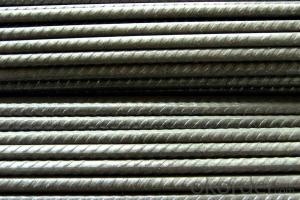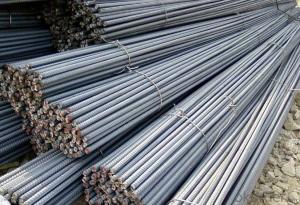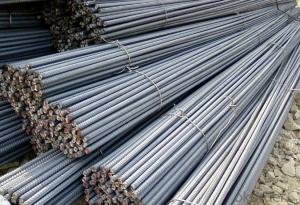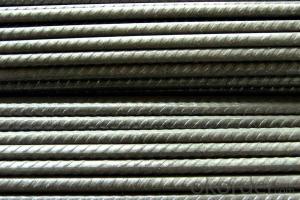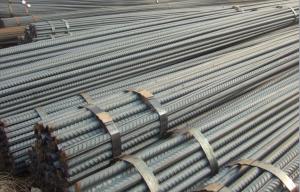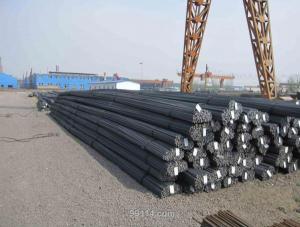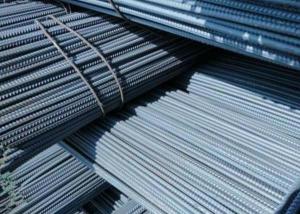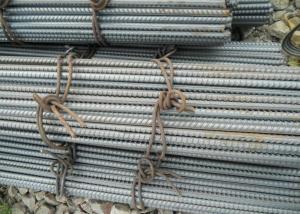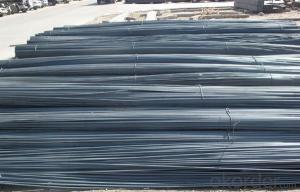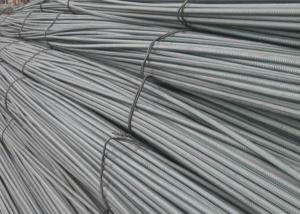Hot Rolled Deformed Bar ou Reinforcement Bar ASTM A615 6mm-50mm
- Loading Port:
- Tianjin
- Payment Terms:
- TT or LC
- Min Order Qty:
- 25 m.t.
- Supply Capability:
- 100000 m.t./month
OKorder Service Pledge
OKorder Financial Service
You Might Also Like
Product Description:
OKorder is offering high quality Hot Rolled Steel I-Beams at great prices with worldwide shipping. Our supplier is a world-class manufacturer of steel, with our products utilized the world over. OKorder annually supplies products to European, North American and Asian markets. We provide quotations within 24 hours of receiving an inquiry and guarantee competitive prices.
Product Applications:
Deformed bar is widely used in buildings, bridges, roads and other engineering construction. Big to highways, railways, bridges, culverts, tunnels, public facilities such as flood control, dam, small to housing construction, beam, column, wall and the foundation of the plate, deformed bar is an integral structure material. With the development of world economy and the vigorous development of infrastructure construction, real estate, the demand for deformed bar will be larger and larger
Product Advantages:
OKorder's Steel I-Beams are durable, strong, and resist corrosion, exact size, regular package, chemical and mechanical properties are stable.
Main Product Features:
· Premium quality
· Prompt delivery & seaworthy packing (30 days after receiving deposit)
· Corrosion resistance
· Can be recycled and reused
· Mill test certification
· Professional Service
· Competitive pricing
Product Specifications:
Manufacture: Hot rolled
Grade: BS4449
Certificates: ISO, SGS, BV, CIQ
Diameter: 6mm,8mm,10mm,12mm,14mm,16mm,18mm,20mm,
22mm,25mm,28mm,32mm,36mm,40mm,50mm
Length: 6M, 9M,12M or as required
Packaging: Export packing, nude packing, bundled
Chemical Composition: (Please kindly find our chemistry of our material based on HRB500 as below for your information)
Grade | Technical data of the original chemical composition (%) | ||||||
C | Mn | Si | S | P | V | ||
HRB400 | ≤0.25 | ≤1.60 | ≤0.80 | ≤0.045 | ≤0.045 | 0.04-0.12 | |
Physical capability | |||||||
Yield Strength (N/cm²) | Tensile Strength (N/cm²) | Elongation (%) | |||||
≥400 | ≥570 | ≥14 | |||||
Theoretical weight and section area of each diameter as below for your information:
Diameter(mm) | Section area (mm²) | Mass(kg/m) | Weight of 12m bar(kg) |
6 | 28.27 | 0.222 | 2.664 |
8 | 50.27 | 0.395 | 4.74 |
10 | 78.54 | 0.617 | 7.404 |
12 | 113.1 | 0.888 | 10.656 |
14 | 153.9 | 1.21 | 14.52 |
16 | 201.1 | 1.58 | 18.96 |
18 | 254.5 | 2.00 | 24 |
20 | 314.2 | 2.47 | 29.64 |
22 | 380.1 | 2.98 | 35.76 |
25 | 490.9 | 3.85 | 46.2 |
28 | 615.8 | 4.83 | 57.96 |
32 | 804.2 | 6.31 | 75.72 |
36 | 1018 | 7.99 | 98.88 |
40 | 1257 | 9.87 | 118.44 |
50 | 1964 | 15.42 | 185.04 |
FAQ:
Q1: Why buy Materials & Equipment from OKorder.com?
A1: All products offered byOKorder.com are carefully selected from China's most reliable manufacturing enterprises. Through its ISO certifications, OKorder.com adheres to the highest standards and a commitment to supply chain safety and customer satisfaction.
Q2: What makes stainless steel stainless?
A2: Stainless steel must contain at least 10.5 % chromium. It is this element that reacts with the oxygen in the air to form a complex chrome-oxide surface layer that is invisible but strong enough to prevent further oxygen from "staining" (rusting) the surface. Higher levels of chromium and the addition of other alloying elements such as nickel and molybdenum enhance this surface layer and improve the corrosion resistance of the stainless material.
Q3: Can stainless steel rust?
A3: Stainless does not "rust" as you think of regular steel rusting with a red oxide on the surface that flakes off. If you see red rust it is probably due to some iron particles that have contaminated the surface of the stainless steel and it is these iron particles that are rusting. Look at the source of the rusting and see if you can remove it from the surface.
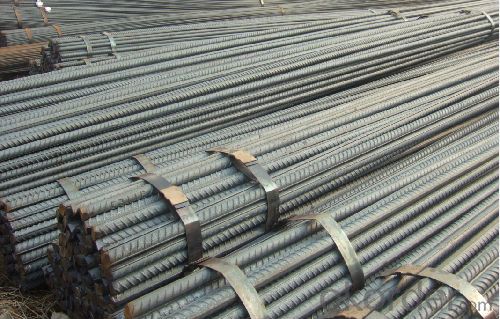

- Q: What is the process of deforming steel rebars for better adhesion with concrete?
- The process of deforming steel rebars for better adhesion with concrete is known as ribbing or rib deformation. This process involves creating small ridges or raised patterns along the surface of the rebar, which enhances the bond between the concrete and the steel. The ribbing process is typically performed through a mechanical operation called cold rolling. Cold rolling is a metalworking process where the steel rebar is passed through a series of rollers, which exert pressure on the surface and cause plastic deformation. The rollers are designed with specific patterns or configurations that create the desired ribbing on the rebar. The purpose of ribbing is to increase the surface area of the rebar in contact with the concrete. The ridges or patterns created by the ribbing process provide additional points of adhesion for the concrete to grip onto, significantly improving the bond strength between the two materials. This enhanced bond is crucial for reinforcing concrete structures, as it helps to distribute loads and resist tensile forces. The ribbing process is commonly used in the construction industry for reinforcing concrete structures such as beams, columns, and slabs. The specific pattern and depth of the ribbing may vary depending on the project requirements and the type of rebar being used. Manufacturers often adhere to industry standards and guidelines to ensure the proper design and placement of ribbed rebars. In summary, the process of deforming steel rebars for better adhesion with concrete involves ribbing or creating ridges on the rebar's surface. This is achieved through cold rolling, where the rebar is passed through rollers designed with specific patterns. Ribbing increases the surface area and provides additional points of adhesion, improving the bond between the concrete and the rebar.
- Q: What is the role of steel rebars in bridge construction?
- The role of steel rebars in bridge construction is to provide reinforcement and strength to the concrete structure. Rebars are embedded within the concrete to enhance its ability to withstand tension forces, increase durability, and prevent cracking or failure. They help distribute the load across the bridge, ensuring its stability and longevity.
- Q: How are steel rebars protected from vandalism during construction?
- Steel rebars are often protected from vandalism during construction by implementing security measures such as fencing around the construction site, hiring security personnel to monitor the area, and installing surveillance cameras. Additionally, construction companies may choose to store the rebars in secure locations within the site or cover them with protective materials to deter potential vandals.
- Q: Can steel rebars be used in dams and reservoirs construction?
- Yes, steel rebars can be used in dams and reservoirs construction. Steel rebars are commonly used in concrete construction projects, including dams and reservoirs, due to their high tensile strength and durability. Dams and reservoirs require materials that can withstand the immense pressure exerted by the water, and steel rebars provide the necessary reinforcement to ensure the structural integrity of the concrete. These rebars are typically embedded within the concrete to provide additional strength and prevent cracking or collapse. Additionally, steel rebars are resistant to corrosion, which is crucial in dam and reservoir construction as they are often exposed to water for extended periods. Overall, steel rebars are an essential component in the construction of dams and reservoirs, as they enhance the strength and longevity of the structures.
- Q: Can steel rebars be painted or coated?
- Steel rebars can indeed be painted or coated, a common practice in construction and engineering for protecting against corrosion and enhancing their appearance. The procedure involves applying a layer of paint or coating substance onto the rebars' surface. This protective layer acts as a barrier, preventing moisture and other corrosive elements from reaching the steel, thereby extending the rebars' lifespan. Furthermore, painting or coating the rebars aids in distinguishing them from other construction materials or facilitating color-coded identification. It is crucial to utilize top-notch paint or coating materials specifically formulated for steel applications to ensure adequate adhesion and durability.
- Q: What is the lifespan of steel rebars in marine structures?
- The lifespan of steel rebars in marine structures can vary depending on various factors such as the quality of the steel, the environment in which they are exposed, and the maintenance practices employed. However, properly designed, constructed, and maintained marine structures with steel rebars can typically have a lifespan of 50 to 100 years. Steel rebars used in marine structures are generally coated with corrosion-resistant materials, such as epoxy or zinc, to protect them from the harsh marine environment. These coatings provide an additional layer of defense against corrosion, extending the lifespan of the rebars. However, it is important to note that the marine environment is highly corrosive due to the presence of saltwater, humidity, and other corrosive agents. Over time, these factors can lead to the degradation of the protective coatings and the exposure of the rebars to corrosion. If adequate maintenance measures are not taken, such as regular inspections, cleaning, and reapplication of protective coatings, the rebars may experience accelerated corrosion and their lifespan may be shortened. Additionally, the design and construction of marine structures play a crucial role in determining the lifespan of steel rebars. Proper considerations must be given to factors such as structural design, material selection, and detailing to minimize the risk of corrosion and ensure the longevity of the rebars. In summary, the lifespan of steel rebars in marine structures can range from 50 to 100 years, depending on factors such as the quality of the steel, the environmental conditions, and the maintenance practices employed. Proper design, construction, and maintenance are essential to maximizing the lifespan of steel rebars in marine structures.
- Q: Can steel rebars be used in soundproof structures?
- Steel rebars can be used in soundproof structures, but they are not the sole component responsible for soundproofing. Steel rebars are primarily used for reinforcement in concrete structures, such as walls or floors. While they can help in reducing sound transmission to some extent, additional soundproofing materials and techniques are necessary to achieve effective soundproofing. To create a soundproof structure, several factors need to be considered. One important factor is the mass of the structure. Steel rebars, being heavy and dense, contribute to increasing the mass of the structure, which helps in reducing sound transmission. However, the effectiveness of soundproofing also depends on the overall design, construction techniques, and the incorporation of other sound-absorbing materials. To enhance the soundproofing capabilities of a structure, other materials can be added, such as acoustic insulation, soundproofing panels, or resilient channels. Acoustic insulation materials, such as mineral wool or acoustic foam, can be installed within the walls or floors to absorb sound waves and prevent them from traveling through the structure. Soundproofing panels can also be added to surfaces to reflect or absorb sound waves, further reducing noise transmission. Moreover, proper construction techniques should be employed to ensure that there are no gaps or air leaks that could allow sound to pass through. Using resilient channels, which isolate the structure from the surrounding surfaces, can also help in reducing sound transmission. In conclusion, while steel rebars can contribute to soundproofing a structure by increasing its mass, they alone are not sufficient to create a completely soundproof environment. Effective soundproofing requires a combination of design, construction techniques, and the incorporation of additional sound-absorbing materials to achieve the desired level of sound reduction.
- Q: What are the factors to consider while selecting steel rebars for a construction project?
- When selecting steel rebars for a construction project, there are several factors that should be considered. Firstly, the grade and type of steel rebar should be chosen based on the specific requirements and design of the project. Factors such as the expected loads, environmental conditions, and the type of structure being built will influence the choice of steel rebar. Additionally, the diameter and spacing of the rebars should be determined based on the structural design and the anticipated stresses on the project. The corrosion resistance and durability of the rebars, as well as their ability to bond with concrete, should also be taken into account. Lastly, the availability and cost of the steel rebars should be considered to ensure the project remains within budget without compromising on quality.
- Q: How do steel rebars contribute to the overall cost-effectiveness of a construction project?
- Steel rebars contribute to the overall cost-effectiveness of a construction project in several ways. Firstly, steel rebars provide structural strength and reinforcement, reducing the need for additional materials and increasing the lifespan of the structure. Secondly, steel rebars are durable and low-maintenance, reducing long-term repair and replacement costs. Additionally, steel rebars can be easily fabricated and installed, saving time and labor costs during construction. Overall, the use of steel rebars ensures a more efficient and cost-effective construction process and enhances the longevity and durability of the project.
- Q: How are steel rebars protected during concrete pouring?
- Steel rebars are typically protected during concrete pouring by being encased within the concrete mixture. This helps to prevent corrosion and maintain the structural integrity of the rebars. Additionally, specific coatings or epoxy can be applied to the rebars to provide an extra layer of protection against corrosion.
Send your message to us
Hot Rolled Deformed Bar ou Reinforcement Bar ASTM A615 6mm-50mm
- Loading Port:
- Tianjin
- Payment Terms:
- TT or LC
- Min Order Qty:
- 25 m.t.
- Supply Capability:
- 100000 m.t./month
OKorder Service Pledge
OKorder Financial Service
Similar products
Hot products
Hot Searches
Related keywords
